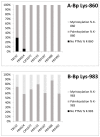Characterization of Post-Translational Modifications and Cytotoxic Properties of the Adenylate-Cyclase Hemolysin Produced by Various Bordetella pertussis and Bordetella parapertussis Isolates
- PMID: 28954396
- PMCID: PMC5666351
- DOI: 10.3390/toxins9100304
Characterization of Post-Translational Modifications and Cytotoxic Properties of the Adenylate-Cyclase Hemolysin Produced by Various Bordetella pertussis and Bordetella parapertussis Isolates
Abstract
Bordetella pertussis and Bordetella parapertussis are the causal agents of whooping cough in humans. They produce diverse virulence factors, including adenylate cyclase-hemolysin (AC-Hly), a secreted toxin of the repeat in toxins (RTX) family with cyclase, pore-forming, and hemolytic activities. Post-translational modifications (PTMs) are essential for the biological activities of the toxin produced by B. pertussis. In this study, we compared AC-Hly toxins from various clinical isolates of B. pertussis and B. parapertussis, focusing on (i) the genomic sequences of cyaA genes, (ii) the PTMs of partially purified AC-Hly, and (iii) the cytotoxic activity of the various AC-Hly toxins. The genes encoding the AC-Hly toxins of B. pertussis and B. parapertussis displayed very limited polymorphism in each species. Most of the sequence differences between the two species were found in the C-terminal part of the protein. Both toxins harbored PTMs, mostly corresponding to palmitoylations of the lysine 860 residue and palmoylations and myristoylations of lysine 983 for B. pertussis and AC-Hly and palmitoylations of lysine 894 and myristoylations of lysine 1017 for B. parapertussis AC-Hly. Purified AC-Hly from B. pertussis was cytotoxic to macrophages, whereas that from B. parapertussis was not.
Keywords: Bordetella parapertussis; Bordetella pertussis; PTMs; adenylate cyclase hemolysin.
Conflict of interest statement
The authors declare no conflicts of interest.
Figures





References
-
- Parkhill J., Sebaihia M., Preston A., Murphy L.D., Thomson N., Harris D.E., Holden M.T., Churcher C.M., Bentley S.D., Mungall K.L., et al. Comparative analysis of the genome sequences of Bordetella pertussis, bordetella parapertussis and bordetella bronchiseptica. Nat. Genet. 2003;35:32–40. doi: 10.1038/ng1227. - DOI - PubMed
MeSH terms
Substances
LinkOut - more resources
Full Text Sources
Other Literature Sources
Miscellaneous

